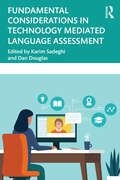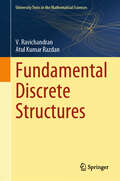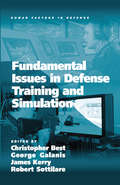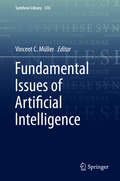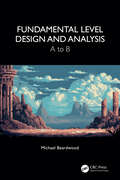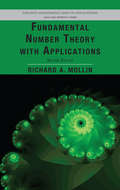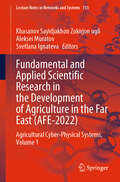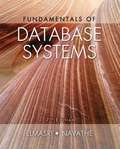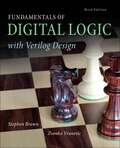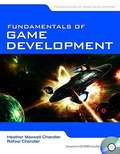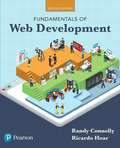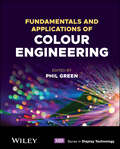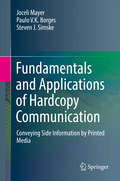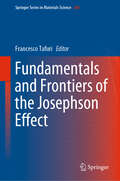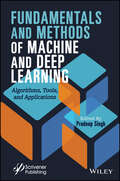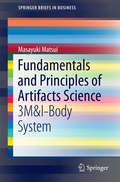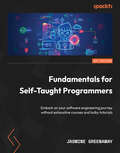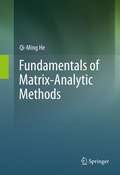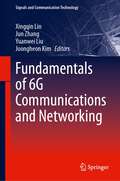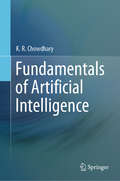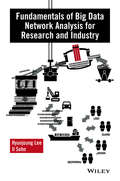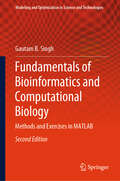- Table View
- List View
Fundamental Considerations in Technology Mediated Language Assessment
by Karim Sadeghi and Dan DouglasFundamental Considerations in Technology Mediated Language Assessment aims to address issues such as how the forced integration of technology into second language assessment has shaped our understanding of key traditional concepts like validity, reliability, washback, authenticity, ethics, fairness, test security, and more. Although computer assisted language testing has been around for more than two decades in the context of high-stakes proficiency testing, much of language testing worldwide has shifted to 'at home' mode, and relies heavily on the mediation of digital technology, making its widespread application in classroom settings in response to the COVID-19 outbreak as unprecedented. Integration of technology into language assessment has brought with it countless affordances and at the same time challenges, both theoretically and practically. One major theoretical consideration requiring attention is the way technology has contributed to a re-conceptualisation of major assessment concepts/constructs. There is very limited literature available on theoretical underpinnings of technology mediated language assessment. This book aims to fill this gap. This book will appeal to academic specialists, practitioners or professionals in the field of language assessment, advanced and/or graduate students, and a range of scholars or professionals in disciplines like educational technology, applied linguistics and TESOL.
Fundamental Discrete Structures (University Texts in the Mathematical Sciences)
by Atul Kumar Razdan V. RavichandranThis book serves as a core text in discrete mathematics. It discusses topics such as symbolic logic, enumerative combinatorics, algebraic structures, graph theory, and related applications to computer science and other allied subjects. The presentation of related concepts is suitable for sophomore, junior, and senior-level undergraduate students. Exercises provided at the end of each chapter are designed to help the reader have an active learning experience throughout the study.
Fundamental Issues in Defense Training and Simulation (Human Factors in Defence)
by George Galanis Robert SottilareDefense forces have always invested a great deal of their resources in training. In recent times, changes in the complexity and intensity of operations have reaffirmed the importance of ensuring that warfighters are adequately prepared for the environments in which they are required to work. The emergence of new operational drivers such as asymmetric threats, urban operations, joint and coalition operations and the widespread use of military communications and information technology networks has highlighted the importance of providing warfighters with the competencies required to act in a coordinated, adaptable fashion, and to make effective decisions in environments characterized by large amounts of sometimes ambiguous information. While investment in new technologies can make available new opportunities for action, it is only through effective training that personnel can be made ready to apply their tools in the most decisive and discriminating fashion. There are many factors which can have an impact on the efficacy of training and many issues to consider when designing and implementing training strategies. These issues are often complex and nuanced, and in order to grasp them fully a significant investment of time and energy is required. However, the requirement to respond quickly to ever-changing technology, a high operational tempo and minimal staffing may preclude many in today's defense forces from seeking out all such resources on their own. This edited collection provides brief, easy-to-understand summaries of the key issues in defense training and simulation, as well as guidance for further reading. It consists of a collection of short essays, each of which addresses a fundamental issue in defense training and simulation, and features an up-to-date reference list to enable the reader to undertake further investigation of the issues addressed. In essence, this book provides the optimum starting point, or first resource, for readers to come to terms with the important issues associated with defense training and simulation. The contributions are written by leading scholars from military research institutions in the US, UK, Canada, Australia and New Zealand, as well as selected researchers from academic and private sector research institutions.
Fundamental Issues of Artificial Intelligence
by Vincent C. MüllerThis volume offers a look at the fundamentalissues of present and future AI, especially from cognitive science, computerscience, neuroscience and philosophy. This work examines the conditionsfor artificial intelligence, how these relate to the conditions for intelligencein humans and other natural agents, as well as ethical and societal problemsthat artificial intelligence raises or will raise. The key issues this volume investigates include the relation of AI andcognitive science, ethics of AI and robotics, brain emulation andsimulation, hybrid systems and cyborgs, intelligence and intelligence testing,interactive systems, multi-agent systems, and super intelligence. Based on the 2nd conference on "Theory and Philosophy of ArtificialIntelligence" held in Oxford, the volume includes prominentresearchers within the field from around the world.
Fundamental Issues of Artificial Intelligence (Synthese Library #376)
by Vincent C. MüllerThis volume offers a look at the fundamental issues of present and future AI, especially from cognitive science, computer science, neuroscience and philosophy. This work examines the conditions for artificial intelligence, how these relate to the conditions for intelligence in humans and other natural agents, as well as ethical and societal problems that artificial intelligence raises or will raise. The key issues this volume investigates include the relation of AI and cognitive science, ethics of AI and robotics, brain emulation and simulation, hybrid systems and cyborgs, intelligence and intelligence testing, interactive systems, multi-agent systems, and super intelligence. Based on the 2nd conference on “Theory and Philosophy of Artificial Intelligence” held in Oxford, the volume includes prominent researchers within the field from around the world.
Fundamental Level Design and Analysis: A to B
by Michael BeardwoodThis book provides a starting point for anyone interested in level and game design with zero prior knowledge. By analysing existing games and levels, it introduces good design ideas and works towards communicating them in either design or practical methods. The book covers a multitude of design standards and showcases relatively easy methods of communicating ideas to an industry standard.This book uses step-by-step discussion to show how and why certain methodologies work, and covers the key topics needed to understand level design, including mapping, blockouts, flow maps, critical paths, and affordance.This book will be suitable for undergraduate students studying game design courses, as well as those looking to learn the basics of level design.
Fundamental Number Theory with Applications
by Richard A. MollinAn update of the most accessible introductory number theory text available, Fundamental Number Theory with Applications, Second Edition presents a mathematically rigorous yet easy-to-follow treatment of the fundamentals and applications of the subject. The substantial amount of reorganizing makes this edition clearer and more elementary in i
Fundamental and Applied Scientific Research in the Development of Agriculture in the Far East: Agricultural Cyber-Physical Systems, Volume 1 (Lecture Notes in Networks and Systems #733)
by Aleksei Muratov Svetlana Ignateva Khasanov Sayidjakhon Zokirjon ugliThe scope of this book is cyber-physical systems used for the sustainable development and productivity of the agricultural sector. The book contains proceedings of the conference “Fundamental and Applied Scientific Research in the Development of Agriculture in the Far East” (AFE-2022, Tashkent, Uzbekistan). The results of research in the following areas are presented here: software-as-a-service solutions for orchard management, ICT components of Smart Agriculture (SA), farm management platforms, yield monitoring and estimation, IoTs in farming, water management, and smart agriculture machines. The book contains information on the latest technologies in precision agriculture, including real-time technology and big data analytics, fertilizer and sprayer controllers, robotics, variable rate irrigation, networks and remote sensing technologies, etc. The research results presented in the book help in making the right decisions about the allocation of resources in agricultural systems.
Fundamentals Of Database Systems
by Ramez Elmasri Shamkant B. NavatheFor database systems courses in Computer Science This book introduces the fundamental concepts necessary for designing, using, and implementing database systems and database applications. Our presentation stresses the fundamentals of database modeling and design, the languages and models provided by the database management systems, and database system implementation techniques. The book is meant to be used as a textbook for a one- or two-semester course in database systems at the junior, senior, or graduate level, and as a reference book. The goal is to provide an in-depth and up-to-date presentation of the most important aspects of database systems and applications, and related technologies. It is assumed that readers are familiar with elementary programming and data-structuring concepts and that they have had some exposure to the basics of computer organization.
Fundamentals Of Digital Logic With Verilog Design
by Stephen Brown Zvonko VranesicFundamentals of Digital Logic With Verilog Designteaches the basic design techniques for logic circuits. It emphasizes the synthesis of circuits and explains how circuits are implemented in real chips. Fundamental concepts are illustrated by using small examples. Use of CAD software is well integrated into the book. The CAD software provides automatic mapping of a design written in Verilog into Field Programmable Gate Arrays (FPGAs) and Complex Programmable Logic Devices (CPLDs). Students will be able to try, firsthand, the book's Verilog examples (over 140) and homework problems. Engineers use Quartus CAD for designing, simulating, testing and implementing logic circuits. The version included with this text supports all major features of the commercial product and comes with a compiler for the IEEE standard Verilog language. Students will be able to: enter a design into the CAD system compile the design into a selected device simulate the functionality and timing of the resulting circuit implement the designs in actual devices (using the school's laboratory facilities) Verilog is a complex language, so it is introduced gradually in the book. Each Verilog feature is presented as it becomes pertinent for the circuits being discussed. To teach the student to use the Quartus CAD, the book includes three tutorials.
Fundamentals Of Game Development (Foundations of Game Development)
by Heather Maxwell Chandler Rafael ChandlerWritten by veterans who are currently working in the game industry, Fundamentals of Game Development is unique because it provides the practical aspects of the processes involved in developing and completing game projects. Designed for introductory game development and game production courses, this text provides a hands-on approach using examples and exercises to walk the reader through the entire process of developing a game from concept to completion. The book covers the basic topics discussed in an introductory text as well as history, game genres, design, story-telling, character creation, pre-production, code release, career descriptions, and more.
Fundamentals Of Web Development
by Randy Connolly Ricardo HoarWelcome to the Fundamentals of Web Development. This textbook is intended to cover the broad range of topics required for modern web development and is suitable for intermediate to upper-level computing students. A significant percentage of the material in this book has also been used by the authors to teach web development principles to first-year computing students and to non-computing students as well.
Fundamentals and Applications of Colour Engineering (Wiley Series in Display Technology)
by Phil GreenFUNDAMENTALS AND APPLICATIONS OF COLOUR ENGINEERING EXPERT OVERVIEW OF THE WORLD OF COLOUR ENGINEERING IN THE 21ST CENTURY, WITH NEW, UPDATED TECHNOLOGIES AND A MATLAB TOOLBOX Fundamentals and Applications of Colour Engineering provides important coverage on topics that hold the power to extend our knowledge of colour reproduction, such as colour measurement and appearance and the methods used, with additional discussion of the technologies responsible for reproducing colour across a wide range of devices, together with the colour management systems that are used to connect devices and exchange information. Composed of 20 chapters, the Editor and his team of expert contributors consider the new ICC.2 architecture, an approach that introduces an evolutionary step in colour engineering, ensuring wider possibilities for technology. The text also considers the emerging applications for advanced colour management, such as processing spectral data, handling HDR images, and the capture and reproduction of material appearance. The text is supported by a MATLAB toolbox of relevant functions and data. Fundamentals and Applications of Colour Engineering is a useful reference for anyone involved in the reproduction of colour and a strong supplementary course potential for master???s degrees with a colour science component. Fundamentals and Applications of Colour Engineering includes information on: Instruments and methods of colour measurement, colorimetry, and colour difference, and colour appearance Colour spaces and colour encodings, and characterizing input devices, displays and printers Colour gamut communication and imaging standards, high dynamic range imaging, and HDR Sensor adjustment in colour management, open source tools for colour engineering, and colour transform evaluation Supporting active learning with the inclusion of a toolbox of relevant functions and data, Fundamentals and Applications of Colour Engineering is an essential resource for students in relevant programs of study, and for professionals within colour engineering and reproduction looking to maximize their skill set and keep their skills updated.
Fundamentals and Applications of Hardcopy Communication: Conveying Side Information By Printed Media
by Steven J. Simske Joceli Mayer Paulo V.K. BorgesThis book presents covert, semi-covert and overt techniques for communication over printed media by modifying images, texts or barcodes within the document. Basic and advanced techniques are discussed aimed to modulate information into images, texts and barcodes.Conveying information over printed media can be useful for content authentication, author copyright, information and piracy product deterrent, side information for marketing, among other applications. Practical issues are discussed and experiments are provided to evaluate competitive approaches for hard-copy communication.This book is a useful resource for researchers, practitioners and graduate students in the field of hard-copy communication by providing the fundamentals, basic and advanced techniques as examples of approaches to address the hard-copy media distortions and particularities.
Fundamentals and Frontiers of the Josephson Effect (Springer Series in Materials Science #286)
by Francesco TafuriThis book provides a comprehensive and up-to-date description of the Josephson effect, a topic of never-ending interest in both fundamental and applied physics. In this volume, world-renowned experts present the unique aspects of the physics of the Josephson effect, resulting from the use of new materials, of hybrid architectures and from the possibility of realizing nanoscale junctions. These new experimental capabilities lead to systems where novel coherent phenomena and transport processes emerge. All this is of great relevance and impact, especially when combined with the didactic approach of the book. The reader will benefit from a general and modern view of coherent phenomena in weakly-coupled superconductors on a macroscopic scale. Topics that have been only recently discussed in specialized papers and in short reviews are described here for the first time and organized in a general framework. An important section of the book is also devoted to applications, with focus on long-term, future applications. In addition to a significant number of illustrations, the book includes numerous tables for comparative studies on technical aspects.
Fundamentals and Methods of Machine and Deep Learning: Algorithms, Tools, and Applications
by Pradeep SinghFUNDAMENTALS AND METHODS OF MACHINE AND DEEP LEARNING The book provides a practical approach by explaining the concepts of machine learning and deep learning algorithms, evaluation of methodology advances, and algorithm demonstrations with applications. Over the past two decades, the field of machine learning and its subfield deep learning have played a main role in software applications development. Also, in recent research studies, they are regarded as one of the disruptive technologies that will transform our future life, business, and the global economy. The recent explosion of digital data in a wide variety of domains, including science, engineering, Internet of Things, biomedical, healthcare, and many business sectors, has declared the era of big data, which cannot be analysed by classical statistics but by the more modern, robust machine learning and deep learning techniques. Since machine learning learns from data rather than by programming hard-coded decision rules, an attempt is being made to use machine learning to make computers that are able to solve problems like human experts in the field. The goal of this book is to present a??practical approach by explaining the concepts of machine learning and deep learning algorithms with applications. Supervised machine learning algorithms, ensemble machine learning algorithms, feature selection, deep learning techniques, and their applications are discussed. Also included in the eighteen chapters is unique information which provides a clear understanding of concepts by using algorithms and case studies illustrated with applications of machine learning and deep learning in different domains, including disease prediction, software defect prediction, online television analysis, medical image processing, etc. Each of the chapters briefly described below provides both a chosen approach and its implementation. Audience Researchers and engineers in artificial intelligence, computer scientists as well as software developers.
Fundamentals and Principles of Artifacts Science
by Masayuki MatsuiThis is the first book covering original information on the mathematical science of such the artifacts as 3M&I-body system, in which "3M" means human, material/machine, money, and "I" means the information/method in nature versus artifacts. This book is the product of industrial engineering versus Wiener's cybernetics challenge for a half-century. For 3M&I-body, there are two approaches of artificial intelligence/IoT (internet of things) and Matsui's matrix/3D to systemization and control. The former is the analogical and visual approach to real entity. The latter is the digital and logical approach to system decision and is applied to the robotics of bodies. The mathematical science of a body is well constructed from the algebra, geometry, analysis, and control on Matsui's equation, toward the sandwich and balancing propositions of bodies. The sandwich issues propose the squeeze or pinching theorem in mathematics at the 3M&I-body, and the balancing issues propose the principle of balancing and invisible collaboration of bodies, beginning from the work of Archimedes. This book contributes to the integration of knowledge and intelligence in science and facilitate the realization of the cyber/real-world , such as the enterprise robot, cloud-coordinated supply-chain management (SCM), and smart cities in the near future.
Fundamentals for Self-Taught Programmers: Embark on your software engineering journey without exhaustive courses and bulky tutorials
by Jasmine GreenawayAn absolute beginner's guide to strengthening the fundamentals before learning your first programming languagePurchase of the print or Kindle book includes a free PDF eBookKey FeaturesExplore fundamental computer science concepts from data structures through to object-oriented programmingProgress from understanding the software engineering landscape to writing your first programAuthored by a Microsoft community insider and filled with case studies from software engineering rolesBook DescriptionSoftware engineering is a set of techniques, including programming, within the computer science discipline associated with the development of software products. This practical guide to software engineering will enable aspiring and new developers to satisfy their curiosity about the industry and become ready to learn more about the basics before beginning to explore programming languages, along with helping junior and upcoming developers to effectively apply their knowledge in the field. The book begins by providing you with a comprehensive introduction to software engineering, helping you gain a clear, holistic understanding of its various sub-fields. As you advance, you'll get to grips with the fundamentals of software engineering, such as flow control, data structures and algorithms. The book also introduces you to C# and guides you in writing your first program. The concluding chapters will cover case studies, including people working in the industry in different engineering roles, as well as interview tips and tricks and coding best practices. By the end of this programming book, you'll have gained practical knowledge of the implementation and associated methodologies in programming that will have you up and running and productive in no time.What you will learnGain an understanding of the software engineering landscapeGet up and running with fundamental programming concepts in C#Implement object-oriented programming (OOP) in C#Gain insights on how to keep the code readable and reusableDiscover various tips and tricks to efficiently prepare for a software engineering interviewImplement various popular algorithms using C#Who this book is forThis book is for anyone who is curious about programming and interested in entering the field of software engineering by beginning at the fundamentals. No prior knowledge of computer science or software engineering is necessary.
Fundamentals in Assistive Technology 4th Edition
by Michelle L. LangeAn Introduction to Assistive Technology Implementation in the Lives of People with Disabilities
Fundamentals of Matrix-Analytic Methods
by Qi-Ming HeFundamentals of Matrix-Analytic Methods targets advanced-level students in mathematics, engineering and computer science. It focuses on the fundamental parts of Matrix-Analytic Methods, Phase-Type Distributions, Markovian arrival processes and Structured Markov chains and matrix geometric solutions. New materials and techniques are presented for the first time in research and engineering design. This book emphasizes stochastic modeling by offering probabilistic interpretation and constructive proofs for Matrix-Analytic Methods. Such an approach is especially useful for engineering analysis and design. Exercises and examples are provided throughout the book.
Fundamentals of 6G Communications and Networking (Signals and Communication Technology)
by Jun Zhang Yuanwei Liu Xingqin Lin Joongheon KimThis book begins with a historical overview of the evolution of mobile technologies and addresses two key questions: why do we need 6G? and what will 6G be? The remaining chapters of this book are organized into three parts: Part I covers the foundation of an end-to-end 6G system by presenting 6G vision, driving forces, key performance indicators, and societal requirements on digital inclusion, sustainability, and intelligence. Part II presents key radio technology components for the 6G communications to deliver extreme performance, including new radio access technologies at high frequencies, joint communications and sensing, AI-driven air interface, among others. Part III describes key enablers for intelligent 6G networking, including network disaggregation, edge computing, data-driven management and orchestration, network security and trustworthiness, among others. This book is relevant to researchers, professionals, and academics working in 5G/6G and beyond.
Fundamentals of Artificial Intelligence
by K.R. ChowdharyFundamentals of Artificial Intelligence introduces the foundations of present day AI and provides coverage to recent developments in AI such as Constraint Satisfaction Problems, Adversarial Search and Game Theory, Statistical Learning Theory, Automated Planning, Intelligent Agents, Information Retrieval, Natural Language & Speech Processing, and Machine Vision. The book features a wealth of examples and illustrations, and practical approaches along with the theoretical concepts. It covers all major areas of AI in the domain of recent developments. The book is intended primarily for students who major in computer science at undergraduate and graduate level but will also be of interest as a foundation to researchers in the area of AI.
Fundamentals of Automotive Structures and Battery Electric Vehicle Applications (Synthesis Lectures on Mechanical Engineering)
by Mark DingmanThis book covers three topics; 1) automotive structure foundational information, 2) the physics of important loading conditions & how they influence the structure’s design, and 3) how the physics & design implications are different for the Battery Electric Vehicle (BEV) configuration. Currently, the automotive industry is desperately trying to develop cost competitive BEVs, with mixed success. The underlying engineering principles that enable efficient BEV structure are not well known within the industry and this book will provide that critical information to those seasoned automotive engineers. In many companies, a large portion of those seasoned engineers are nearing retirement and a new generation will be entering the workforce. Many companies are looking for ways to avoid the resulting knowledge loss and this book also addresses that; providing the information needed to quickly bring new engineers up to speed.
Fundamentals of Big Data Network Analysis for Research and Industry
by Hyunjoung Lee Il SohnFundamentals of Big Data Network Analysis for Research and Industry Hyunjoung Lee, Institute of Green Technology, Yonsei University, Republic of Korea Il Sohn, Material Science and Engineering, Yonsei University, Republic of Korea Presents the methodology of big data analysis using examples from research and industry There are large amounts of data everywhere, and the ability to pick out crucial information is increasingly important. Contrary to popular belief, not all information is useful; big data network analysis assumes that data is not only large, but also meaningful, and this book focuses on the fundamental techniques required to extract essential information from vast datasets. Featuring case studies drawn largely from the iron and steel industries, this book offers practical guidance which will enable readers to easily understand big data network analysis. Particular attention is paid to the methodology of network analysis, offering information on the method of data collection, on research design and analysis, and on the interpretation of results. A variety of programs including UCINET, NetMiner, R, NodeXL, and Gephi for network analysis are covered in detail. Fundamentals of Big Data Network Analysis for Research and Industry looks at big data from a fresh perspective, and provides a new approach to data analysis. This book: Explains the basic concepts in understanding big data and filtering meaningful data Presents big data analysis within the networking perspective Features methodology applicable to research and industry Describes in detail the social relationship between big data and its implications Provides insight into identifying patterns and relationships between seemingly unrelated big data Fundamentals of Big Data Network Analysis for Research and Industry will prove a valuable resource for analysts, research engineers, industrial engineers, marketing professionals, and any individuals dealing with accumulated large data whose interest is to analyze and identify potential relationships among data sets.
Fundamentals of Bioinformatics and Computational Biology: Methods and Exercises in MATLAB (Modeling and Optimization in Science and Technologies #19)
by Gautam B. SinghThis book comprehensively covers all the core bioinformatics topics and includes practical examples completed using the MATLAB bioinformatics and machine learning toolboxes™. It is primarily intended as a textbook for engineering and computer science students attending advanced undergraduate and graduate courses in bioinformatics and computational biology. The book develops bioinformatics concepts from the ground up, starting with an introductory chapter on molecular biology and genetics to enable physical science students to appreciate the challenges in biological data management, sequence analysis, and systems biology. The book is divided into five parts. The first one includes a survey of existing biological databases and tools that have become essential in today’s biotechnology research. The second part covers methodologies for retrieving biological information, including fundamental algorithms for sequence comparison, scoring, and determining evolutionary distance. The third part of the book focuses on modeling biological sequences and patterns as Markov chains, covering core principles for analyzing and searching for sequences of significant motifs and biomarkers and developing stochastic ergodic hidden Markov models for biological sequence families. The fourth one is dedicated to systems biology and covers phylogenetic analysis and evolutionary tree computations, as well as gene expression analysis with microarrays. In turn, the last part of the book includes an introduction to machine-learning algorithms for bioinformatics and outlines strategies for developing intelligent diagnostic machine-learning applications, RNA sequence data, and deep learning systems for mass spectrometry data. All in all, this book offers a unique hands-on reference guide to bioinformatics and computational biology. This second edition has been updated to cover additional and most recent databases, and machine learning and deep learning applications in RNA sequence and mass-spectrometry data analysis. Moreover, it presents significant enhancements to the chapter dedicated to microarray analysis, and more practical examples, with additional end-of-chapter problems.
